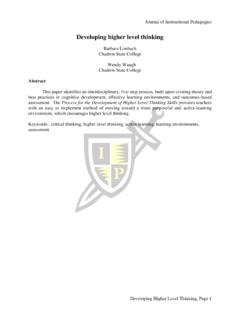Transcription of Data Breaches in Higher Education - AABRI Home Page
1 Journal of Business Cases and Applications Volume 15, December, 2015 data Breaches , Page 1 data Breaches in Higher Education Lori Coleman Holy Family University, Philadelphia, Pennsylvania Bernice M. Purcell, DBA Holy Family University, Philadelphia, Pennsylvania ABSTRACT data Breaches are becoming more common in Higher Education . data compromised in Higher Education Breaches extend far past grades; personal and financial data are abundant at all institutions, and sensitive research data are stored at many large universities. The environment of openness and collaboration at colleges and universities, as well as the typical access of many portable devices make access easier for hackers and detection of unauthorized access difficult. The most common types of data Breaches occurring in college and university systems are hacking and malware, unintentional disclosure, and portable device Breaches .
2 Four universities cases of data Breaches studied are Pennsylvania State University, University of Maryland, North Dakota State University System, and Butler University. Each of the universities experienced a major data breach. The Breaches had many similarities, including remote access and for some the sophistication of the attack. All of the Breaches were costly. College and university administrators need to be prepared for data Breaches , including plans to secure against a breach and react to a breach. Best practices in security and communication of the polices establish preventive measures, while cyber insurance, timely notification, and free fraud protection are typical reactive measures available to college and university administrators.
3 Keywords: data breach, Higher Education , breach prevention, breach reaction Copyright statement: Authors retain the copyright to the manuscripts published in AABRI journals. Please see the AABRI Copyright Policy at Journal of Business Cases and Applications Volume 15, December, 2015 data Breaches , Page 2 INTRODUCTION When the subject of hacking and data Breaches in colleges and universities arises, people tend to think of students hacking into the network to adjust their grades to hide bad performance from their parents and future employers. However, recent data Breaches at several universities have shown that student grades are not the main. Chabrow (2015) explains that university systems are seen as ideal targets for hackers since the systems contain sensitive personal data as well as an abundance of intellectual property from researchers.
4 Chabrow describes the cyber-criminals infiltrating the institutional systems as well-funded and highly skilled perpetrators who have become brazen in their attacks. Nick Bennett, senior manager at Mandiant, told Reuters (Kumar, 2015) that cyber-attacks similar to the one at Penn State in 2015 are the new normal and that no company or organization is immune. The hacks are sophisticated, difficult to detect and often linked to international threat actors. Colleges and universities have large amounts of data and are difficult to secure. Hackers have used several methods to hack Higher educational institutions in the last couple of years from hacking and malware to skimming hardware and insider attacks. According to information from the massive database maintained by Privacy Rights Clearinghouse, 30 educational institutions experienced data Breaches in 2014 alone.
5 Five of the 30 Higher educational institutions actually had larger data Breaches than the notorious Sony Hack. (McCarthy, 2015) This paper examines data targets at universities, types of Breaches to access the data , several recent university Breaches and suggested actions to prevent such attacks. WHAT ATTRACTS HACKERS TO COLLEGE AND UNIVERSITY data ? Educational institutions are seen as an "easy target" for cyber-attackers according to Tyler Shields, a security analyst at Forrester Research (Roman, 2014). Shields, who previously worked for Rochester Institute of Technology in New York, states that the culture of academic institutions is one of open communication and collaboration among students, staff, faculty members and research groups. The network users are highly mobile and are accustomed to networking and accessing the network whenever and wherever they are and on any device.
6 The academic culture of openness and unencumbered access to content and data makes college and university networks extremely difficult to secure. The lax security allowing open access and the presence of cutting-edge academic research and content on the networks make educational institutions an attractive target for attackers (Roman, 2014). In an article in (Straumshein, 2015), Chad Holmes, a chief security strategist with FireEye, makes similar statements about the culture of Higher Education and difficulties of securing their networks. Like Shields, Holmes said that it is the nature of universities which makes the networks tougher to secure. Holmes continues that universities are more difficult to secure than companies and government agencies due to the fact that faculty members and students demand more control of their data than do employees of companies and government agencies.
7 While companies may distribute and control the devices that access corporate networks, people use a myriad of devices on college campuses to access data , which poses serious security risks. (Straumshein, 2015) The sheer number of students, faculty, staff, and alumni make university databases an attractive target for hackers. Personally identifiable information (PII) and financial information such as credit card numbers for such a large number of individuals is very attractive. Greenberg Journal of Business Cases and Applications Volume 15, December, 2015 data Breaches , Page 3 (2014) explained that PII and financial data are attractive to hackers since the information can be bought and sold in bulk, often quite cheaply. A structured and rather sophisticated market for PII has been developed.
8 Greenberg continues that university databases contain underlying personal data for thousands, if not millions, of people. If information for a single credit card sells for $10, hacking into a database where thousands of them can be acquired at one time can be extremely lucrative. The cutting edge research being done at universities is also a rich target for hackers. Chambrow (2015) reasons that large research universities would be great targets for hackers who are sponsored by or sell to other governments, including China. Many large universities research and develop sensitive, cutting-edge technology. Rebecca Herold, a security expert, offered her opinion that intellectual property seemed to have been the target of the Penn State University hack.
9 Her reasoning was based on the fact that the original target of the PSU hack was the College of Engineering (Chambrow, 2015) COMMON TYPES OF data Breaches IN Higher Education The categories of data Breaches that are most common in Higher Education are hacking or malware, unintended disclosure, and portable device Breaches . Hacking or malware is defined by the Privacy Rights Clearinghouse as entry into a system by an outside party or data loss due to malware or spyware. Unintended disclosure is the exposure of sensitive or personally identifiable information through website posting or mishandled e-mail, fax, or mail (items sent to the wrong party). Portable device Breaches are those due to portable devices such as laptops, tablets, cell phones, memory devices, etc.
10 That are lost, discarded improperly, or stolen. Researchers at the ECUCAUSE Center for Analysis and Research (ECAR) determined that 36% of Breaches were committed by hacking or malware, 30% by unintended disclosure, and 17% by portable device Breaches (Grama, 2014). FOUR UNIVERSITY CASES Pennsylvania State University Pennsylvania State University (Penn State) was hacked twice in a three year period. Penn State hired Mandiant, the forensic unit of cyber-security firm FireEye Incorporated after the early 2015 breach was discovered. Mandiant s forensic research determined that the first attack took place in September 2012, with the second being mid-2014. Mandiant confirmed that at least one of the two attacks was carried out by a "threat actor" based in China (Kumar, 2015).














